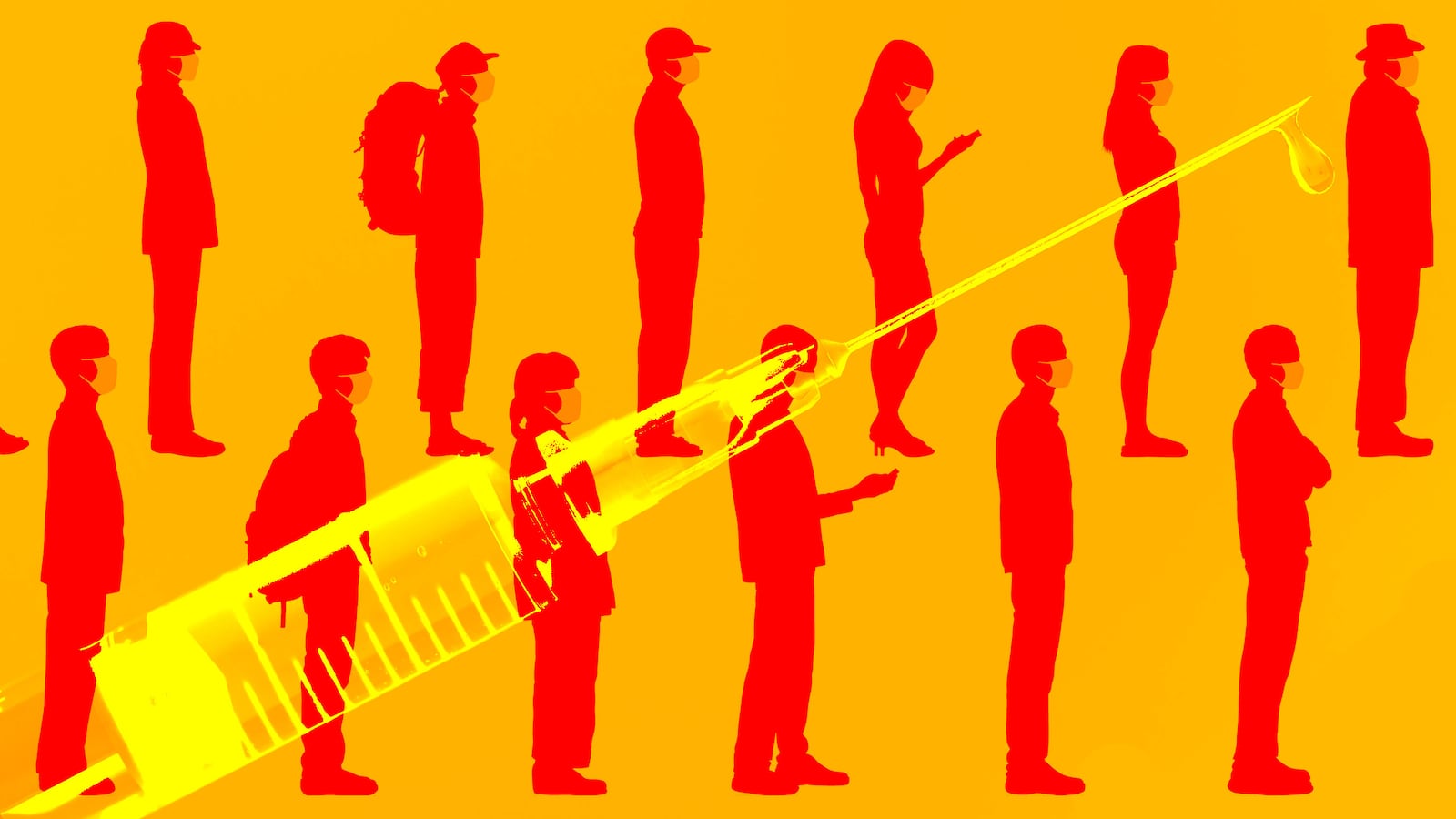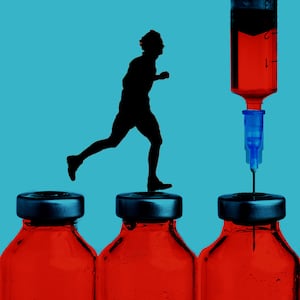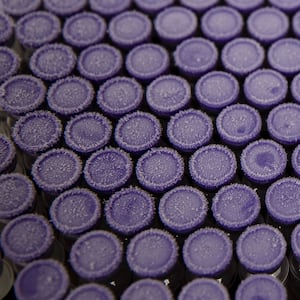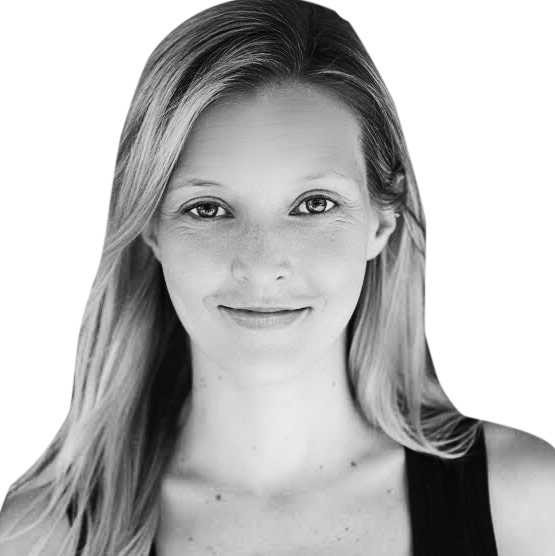Rachel, a 35-year-old therapist in California who has been working from home since March, was standing in line to get a COVID-19 vaccine on Friday when a man approached a nearby volunteer and asked a question. The answer shocked her.
“He asked if this was the line for first responders,” Rachel who spoke under the condition her last name be withheld because her employer prohibits speaking to the press, told The Daily Beast. “The volunteer said something like, ‘It’s not your time yet.’”
In California, first responders are in Phase 1B for vaccinations—after people like Rachel, who works in mental health. Instead of being excited by the prospect of relief from pandemic hell, she was suddenly overcome by a rush of anxiety.
“I was thinking, ‘You’re a first responder. You should definitely be here. Not me,’” she told The Daily Beast.
In short, she added, “The system is super fucked.”
Phase 1A of California’s vaccine allocation plan includes all health-care workers—not just those who are seeing patients in-person—and many of those same workers can’t understand why. It’s a national problem, experts said, one playing out against a backdrop of canceled appointments, supply backlogs, and flagrant line-skipping by young people.
Only in this case, it’s all being done under the auspices of following the rules.
“We’re just valuing the fact that they’re in health care and not thinking about how many people they’re exposed to,” Anna Rappaport, a nurse in Northern California in her thirties and a cancer survivor, told The Daily Beast.
Rappaport has received both of her two coronavirus vaccine shots, she said, but even with her medical history, had her doubts about the process.
“People working from home should not be prioritized over grocery-store workers, janitors, and bus drivers,” she said.
When Rachel was offered a vaccination, she added, the email—reviewed by The Daily Beast—said getting the shot wouldn’t prevent anyone else from doing so, and that if she didn’t, her employer couldn’t guarantee that she would be offered another spot. “I kind of think that’s bullshit though,” she told The Daily Beast. “I mean, I just heard about a hospital that has run out of vaccines.”
Rappaport, who said she received a similar email about her own vaccination, added, “When it’s put that way, it almost feels like a threat.”
A spokesperson for the California Department of Public Health defended the state’s system as guided by a focus on safety, equitable distribution, prioritizing those at highest risk, and transparency. “The California Community Vaccine Advisory Committee, which includes advocates for many underserved groups, including the homeless, immigrants, and farmworkers, is providing input and feedback to the planning efforts and resolving barriers to equitable vaccine implementation and decision-making,” they added.
But California isn’t the only state with a system that seems to be elevating remote workers at little risk by virtue of the industry they fall in.
James Abrams, a therapist and addiction specialist in Maryland who recently got his first shot, said he and his colleagues had concerns about the ethics of getting the vaccine when they could work from home.
“Someone actually wrote to the city [Baltimore] about it,” Abrams said, “And they basically said, ‘Look, we’re trying to get as many shots in as many arms as possible.’”

Adam Abadir, a public information officer for the Baltimore Health Department, said he didn’t recall that particular email, but that the city was following Maryland’s guidelines, which say all licensed health-care workers are in the first tier. Charles Gischlar, deputy director of communications for the Maryland Department of Public Health, told The Daily Beast, “Phase 1A of Maryland’s phased vaccination administration started in mid-December and included all licensed, registered, and certified health-care providers; nursing-home residents and staff; law enforcement, and firefighters, EMS, and other first responders; correctional health-care staff and officers; and frontline judiciary staff.”
“Each individual medical facility prioritized their staff eligible to receive a vaccine in Phase 1A,” he added.
Still, Abrams said, a blanket tier for all health-care workers “does feel like they’re privileging people with access to education.”
Some states that claim to only be giving vaccines to those with in-person contact with patients appeared to be offering the vaccine to health-care workers working from home almost immediately.
Colleen is a 34-year-old clinical psychologist in North Carolina who is working remotely and asked her last name be withheld for fear of professional retaliation. She received an email inviting her to get vaccinated only a few days after “the blowup [among residents] at Stanford [Medical Center in California] not being in the first wave of vaccines,” she said.
That was the first example of a hospital being accused of prioritizing employees who were not fighting COVID up close over those who were, a phenomenon that has since played out nationwide. Which made it all the more surreal and confusing when she was invited to get vaccinated; North Carolina’s guidelines state that only those with in-person patient contact are in tier 1A.
“It’s the great mystery of the tier 1A journey,” she said. “I had my first dose December 20th. That’s before Joe Biden. Someone did something wrong there.” A spokesperson for the state Department of Health did not respond to a request for comment.
Colleen said that everyone she knows who was able to get vaccinated despite working from home feels guilty about it. Being in the first tier would have felt more appropriate if she was going back to work in person. Instead, she said, “I couldn’t even work in person if I wanted to. My badge doesn’t even get me in the building unless I’m scheduled to work that day.”
Laurie Hiner, a 60-year-old systems integration consultant in Pennsylvania, doesn’t know when she or her 82-year-old mother will be able to get the COVID-19 vaccine. But she said she works with a much younger woman who already got a shot.
Hiner’s mother, who lives in a long-term care facility, is in Pennsylvania’s first phase, but the facility hasn’t received any vaccines. Which is why she was so surprised when her colleague, who Hiner estimates is in her twenties, was able to get vaccinated. They’re working on a project for a pharmaceutical company, Hiner said.
“In Philadelphia, they opened it up to people who are in health care but not working directly with patients,” she told The Daily Beast. “She was able to get vaccinated because she said she was in health care with no patient contact.”
In fact, the guidelines refer to “persons not directly involved in patient care but potentially exposed to infectious material that can transmit disease among or from health-care personnel and patients.” While the coworker does have some exposure via her partner who is in food service, Hiner said, it still shocked her that a work-from-home twentysomething could get vaccinated before her mom’s nursing home had received a single vial.
James Garrow, director of the Philadelphia Department of Public Health, told The Daily Beast in an email that in some cases, health-care workers who aren’t seeing patients are eligible for the vaccine. He added, “We acknowledge that, in some of these locations, people who aren’t truly health-care workers may have slipped through.
“We are cognizant that setting up many barriers to ensure that only those who are health-care workers get vaccines can dissuade those who would be prioritized, but may have difficulty proving their standing as a health-care worker,” he said. “So, our verification process for unaffiliated health-care workers is trusting that Philadelphians won’t try to take the vaccine from our health-care heroes.”
Ashish Jha, a physician and the dean of Brown University’s School of Public Health, told The Daily Beast that he thinks virtually everyone can agree frontline health-care workers, like those working in the ICU—as well as hospital staff in those spaces like janitors—should be vaccinated first.
Where the rollout has been “mishandled,” he said, was when hospitals saw their vaccines shipments as “something they almost had a private ownership over and could distribute however they want.”
Jha believes the states’ tiers are “too complicated” and that it might make more sense to have the tiers simply be based on age. Simplicity, he said, will speed things up.
“People are underestimating the importance of being fast right now,” he added.
Jha would also like to see more outreach, especially to vulnerable communities that have been hit hard by the pandemic. “There’s lots of ways of achieving equity without having to do these very complex schemes,” he said.
For her part, Rappaport acknowledges isolation is hard for people working from home—and that might prompt those who don’t really need it to get the shot.
“I get it,” Rappaport said. “I’m an extrovert. But I’m sorry, you don’t need to go to Tahoe with your friends and party.”
What would make Rachel feel a little bit better about being inoculated is if it were determined that the vaccine prevents transmission, which has yet to be demonstrated by scientific trials.
“At least then, I could feel more like I’m doing my part for the community,” she said. “But if it turns out it doesn’t, I’ll feel shitty.”
Right after she found out she was getting vaccinated, Rachel added, she mentioned it in a group chat with some friends, only to learn that a friend’s uncle was dying of COVID.
“I felt so horrible,” Rachel said, “and I hadn’t even gotten it yet. I know my vaccine wasn’t going to save her uncle, but still, I just felt terrible.”




